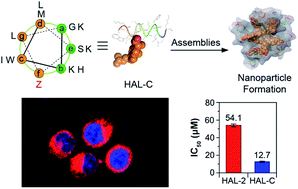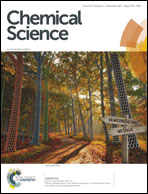Cholesterol-directed nanoparticle assemblies based on single amino acid peptide mutations activate cellular uptake and decrease tumor volume†
Abstract
Peptide drugs have been difficult to translate into effective therapies due to their low in vivo stability. Here, we report a strategy to develop peptide-based therapeutic nanoparticles by screening a peptide library differing by single-site amino acid mutations of lysine-modified cholesterol. Certain cholesterol-modified peptides are found to promote and stabilize peptide α-helix formation, resulting in selectively cell-permeable peptides. One cholesterol-modified peptide self-assembles into stable nanoparticles with considerable α-helix propensity stabilized by intermolecular van der Waals interactions between inter-peptide cholesterol molecules, and shows 68.3% stability after incubation with serum for 16 h. The nanoparticles in turn interact with cell membrane cholesterols that are disproportionately present in cancer cell membranes, inducing lipid raft-mediated endocytosis and cancer cell death. Our results introduce a strategy to identify peptide nanoparticles that can effectively reduce tumor volumes when administered to in in vivo mice models. Our results also provide a simple platform for developing peptide-based anticancer drugs.



 Please wait while we load your content...
Please wait while we load your content...